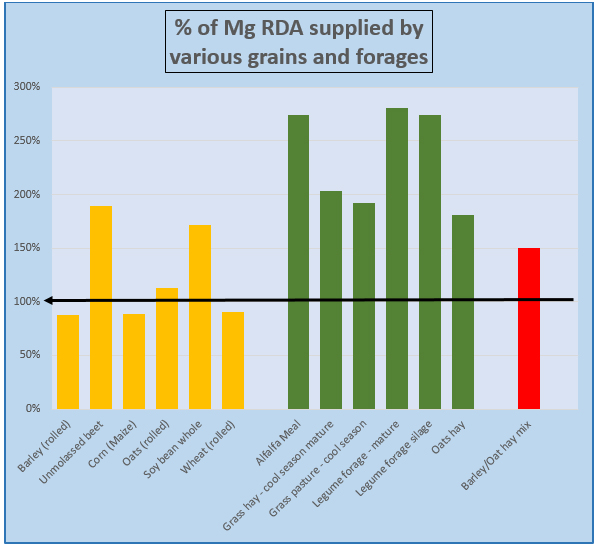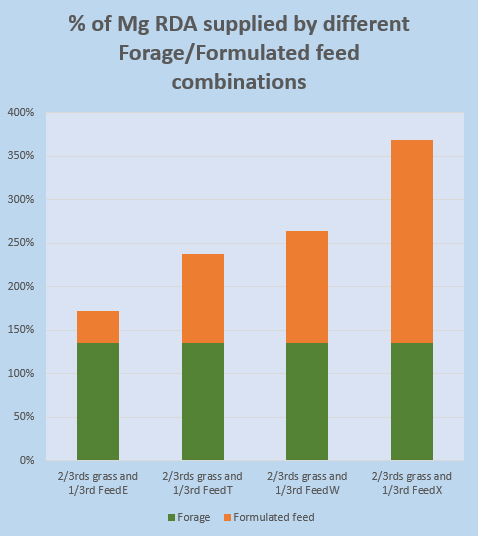 Published 4th June 2017
Published 4th June 2017
How much magnesium is there in my horse’s diet?
If you’re aware that supplementary magnesium doesn’t suit your horse, you may be slightly concerned to know that supplementary magnesium is regularly put into various formulated feeds and balancers. So if you believe you’re feeding a ‘magnesium free’ diet but said diet includes formulated mixes, cubes or balancers then you may be surprised how much supplementary magnesium you’re still giving your horse!
Given that magnesium is a proven sedative and that the science tells us it builds up in the bodies of our horses, we recognise there is a problem here.
This first chart shows how much magnesium there is in a selection of cereal grains and forages according the NRC book “The Nutrient Requirements of Horses”. Now, the science isn’t infallible but it is a good starting point! This chart is based on the needs of a 500kg horse in “Very Heavy Exercise” but the charts for horses in no work or lighter work are very similar.

Let’s start with the six grains (yellow). As you can see, if you fed them as 100% of the horse’s energy needs three of them would be slightly under supplying magnesium and the others would be fine. It is this marginality of cereals that has encouraged feed firms to add a host of nutrients (including magnesium) to formulated feeds based on cereals. Of course in this day and age nobody would feed a diet with that much starch as the risks of colic, laminitis, EMS and ulcers is much better understood nowadays.
The six forages (green) all comfortably exceed the amount of magnesium apparently needed by a very hard working horse. To us this is hardly surprising, as every molecule of chlorophyll in a grass or legume leaf contains magnesium.
The red column shows a diet made up of 1/3rd of the energy from the “worst” cereal and 2/3rds from the “worst” forage. And it contains 150% of the recommended level of magnesium in it.
People will argue that the NRC recommendations are the minimum required – yet our copy of the book doesn’t say that anywhere at all! Even if it were true, creating a modern horse diet that needs added magnesium (according to the NRC science) is pretty difficult to do.
Let’s look at what happens when we substitute the ‘worst case’ hay with ‘Cool Season Mature’ hay and the 1/3rd of cereal grains with some formulated feeds. So in these charts all of the four formulated feeds are providing exactly the same level of energy but clearly very different levels of magnesium:

Firstly the hay alone easily provides more than the RDA for magnesium.
Feed E is a combination of EquiFeast’s CoolCORE and MORE Condition. All the magnesium it provides is naturally occurring in the feed materials.
Feed T is also a balancer and conditioning feed combination from the UK. But here both of those products contain ADDED magnesium. In our experience this level of added magnesium is detrimental to the majority of horses.
Feed W is a more conventional feed from the UK. This feed was used by one of our blood trial horses back in 2011 and behaviour and rideability improved enormously when the horse switched to the development version of Feed E.
Feed X is an Australian product marketed as a “Cool feed”. The amount of magnesium it contains is positively scary.
In 2015 an Australian PhD student (Jess Dodd) showed that horses with approx. 180% and 280% of the RDA showed a similar deterioration in their “Reaction Speed” as the same horses on a dose of the veterinary sedative Acepromazine. Critically she demonstrated that ORAL Magnesium can have this effect.
So if you’re aware your horse doesn’t respond well to supplementary magnesium, then ensure you’re feeding either straights or brands that specifically don’t add supplementary magnesium to their feeds or balancers (such as our CORE&MORE feed range). Otherwise you could find yourself in a situation where you are unwillingly feeding supplementary magnesium without knowing!
Finally it must be said that the RDA is a pretty crude way to look at nutrients like magnesium. Our research suggests that the impact of the source makes a huge difference; the natural magnesium in chlorophyll seems pretty innocuous, while artificial sources like Magnesium Oxide are more potent and modern chelates can be very powerful.
A number of years ago we developed a “Magnesium Factor” to attempt to standardise these factors and encourage all new enquirers to tell us about their horse’s diet and let us look at that aspect. We used this to evaluate the diets that worked best in about 30,000 horses that have gone through our loading and fine tuning process. But these days we don't make life that complicated because 97% of the horses we have introduced to our CORE&MORE diets do best with absolutely no artificial magnesium at all! So now we try to start all horses at that simple point.
Need help knowing how much magnesium is in your horse's feed? Talk to us at advice@equifeast.com or call 01453 836974
Don't take our word for this. Read Alison Stewart's review article on magnesium in horses.
Not sure why a lot supplementary magnesium could be detrimental to your horse? Read all of our magnesium resources.
